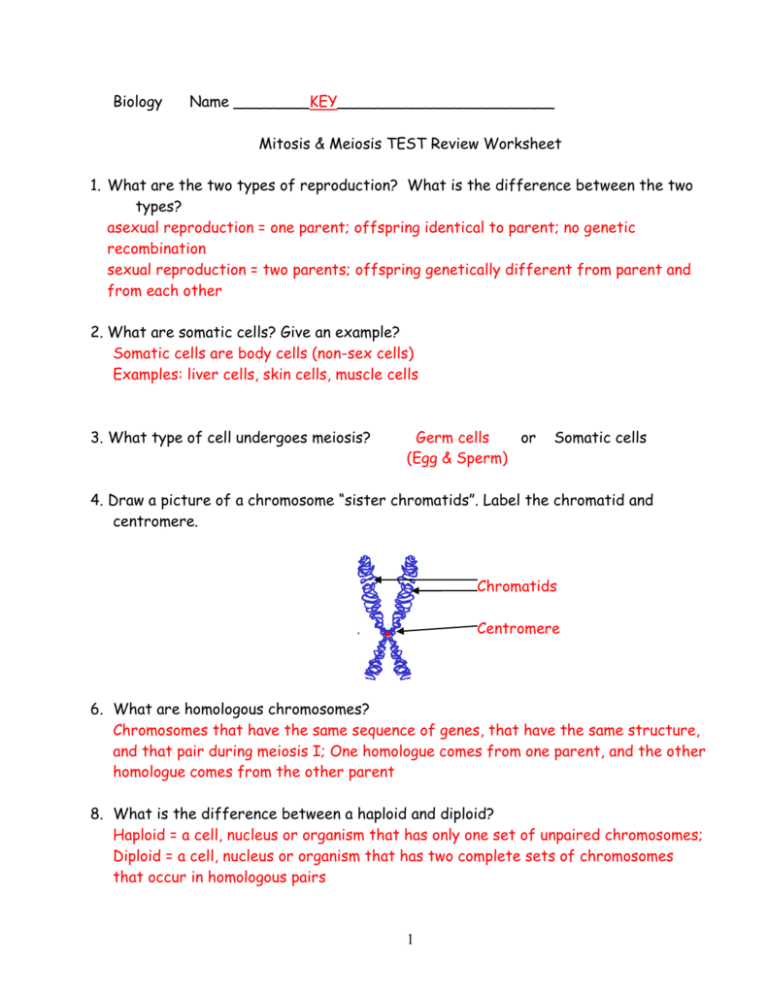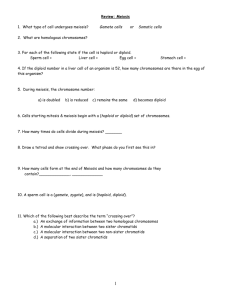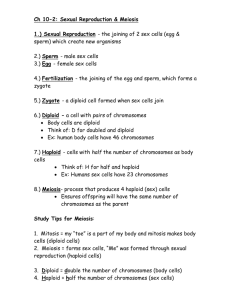Meiosis Review Worksheet
advertisement

Biology Name ________KEY_______________________ Mitosis & Meiosis TEST Review Worksheet 1. What are the two types of reproduction? What is the difference between the two types? asexual reproduction = one parent; offspring identical to parent; no genetic recombination sexual reproduction = two parents; offspring genetically different from parent and from each other 2. What are somatic cells? Give an example? Somatic cells are body cells (non-sex cells) Examples: liver cells, skin cells, muscle cells 3. What type of cell undergoes meiosis? Germ cells or (Egg & Sperm) Somatic cells 4. Draw a picture of a chromosome “sister chromatids”. Label the chromatid and centromere. Chromatids Centromere 6. What are homologous chromosomes? Chromosomes that have the same sequence of genes, that have the same structure, and that pair during meiosis I; One homologue comes from one parent, and the other homologue comes from the other parent 8. What is the difference between a haploid and diploid? Haploid = a cell, nucleus or organism that has only one set of unpaired chromosomes; Diploid = a cell, nucleus or organism that has two complete sets of chromosomes that occur in homologous pairs 1 9. For each of the following state if the cell is haploid or diploid. Sperm cell = haploid Liver cell = diploid Egg cell = haploid Stomach cell = diploid 10. If the diploid number in a liver cell is 52, how many chromosomes are there in the egg of this organism? ___26______ 11. The fusion of a ____haploid egg cell___ and a __haploid sperm cell____ produces a zygote with 46 (2n) chromosome number. 12. During meiosis, the chromosome number: Note: also referred to as reduction division a) is doubled b) is reduced c) remains the same d) becomes diploid 13. Meiosis produces haploid (n) reproductive cells called __gametes___. 14. Name the 2 human gametes & tell their chromosome number (ploidy number). Egg cells (ova); 23 chromosomes **Both are haploid (n)** Sperm cells; 23 chromosomes 15. Cells starting mitosis & meiosis begin with a (haploid or diploid) set of chromosomes. 16. How many times do cells divide during meiosis? __2 times; once in Meiosis I and once in Meiosis II__ 19. What are the stages of meiosis called? Meiosis I: __Prophase I__, __Metaphase I__, __Anaphase I_, ___TelophaseI_____/cytokinesis Meiosis II: Prophase II__, __Metaphase II__, __Anaphase II_, ___TelophaseII_____/cytokinesis 20. What is a tetrad? The four chromoatids in a pair of homologous chromosomes that come together as a result of synapsis during Meiosis I; the chromatids form a “double X” formation 2 21. Which of the following best describe the term “crossing over”? a.) An exchange of information between two homologous chromosomes b.) A molecular interaction between two sister chromatids c.) A molecular interaction between two non-sister chromatids d.) A separation of two sister chromatids 22. What type of material is exchanged during crossing-over? ___DNA/genes_____ 23. Crossing-over can be found in the stage of a.) Prophase I b) Prophase II c) Anaphase I d) Anaphase II 24. Which letter in figure #2 represents meiosis? Why? Letter D represents meiosis because the parent cell is diploid (2n) and there are four haploid (n) daughter cells produced. Figure 2 25. How many cells are formed at the end of Meiosis I & how many copies of chromosomes does each cell have? ___2 cells__, __2 copies (not two sets) that compose the sister chromatids – the cells are haploid__ 26. Is DNA copied before Meiosis II? __no__ 27. How many cells form at the end of Meiosis II and how many chromosomes do they contain? __4 cells___, ___23 chromosomes_(haploid #)__ 28. Oogenesis ultimately gives rise to (one ovum, four ova) with the (haploid, diploid) number of chromosomes. 29. A sperm cell is a (gamete, zygote), and is (haploid, diploid). 3 30. When a sperm cell and an ovum merge, they undergo the process of fertilization, and give rise to a (gamete, zygote), which is (haploid, diploid). 31. A hypothetical organism has 10 chromosomes for each of its body cells (somatic cells). a. Skin cells are continuously being rubbed off and replaced. How many chromosomes will be contained in each new skin cell that is replaced? _10_ b. This replacement occurs through the process of _mitosis__. c. The diploid number (2N) for this organism is _10_. d. This organism would have how many homologous pairs of chromosomes? _5 pairs_ e. The female of this organism has an ovary. The number of chromosomes in each of the cells that make up the ovary would be _10_. f. The mature eggs of this female would contain how many chromosomes? _5__ 4








